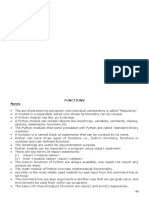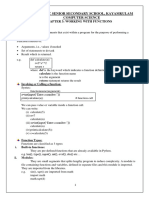Python Functions - Verbose
Uploaded by
mansourPython Functions - Verbose
Uploaded by
mansourFunctions and Modules:
# Defining functions ----------------- # Recursive Function -----------------
def Fibo(x):
if x <= 2: # base case
# Arguments! return 1
def Fcn1(x, y): else:
print(x ** 2 + y) return Fibo(x - 1) + Fibo(x - 2)
# self-reference
Fcn1(11, 3)
print(Fibo(8))
# Function Output; Return like C/C++ -
Function scope: ----------------------
def Fcn2(x):
y = x / 2 # Global Scope
return y x = 2
print('PYthon') # Wont be run --- y = 3
Y = Fcn2(21) def FC1(x):
print(Y) print(x)
print(y)
# Help for function using "Docstrings"
def Root1(a, b, c): FC1(4)
"""
This function can output # Pure and Impure function
roots of quadratic equation # Pure Fcn in only dependent on Args
""" # Impure Fcn output is dependent on
delta = (b**2 - 4*a*c)**0.5 Global vars
x1 = b / 2 - delta / 2
x2 = b / 2 + delta / 2 Anonymous Function using Lambda ------
x = [x1, x2]
return x print((lambda x: x/2 + 5*x**2)(6))
# Single Expression
print(Root1(1, 5, 3)) Lf = lambda x, y: x/2 + 5*x**2 + y
# Assigned to another variables
print(Root1(1, 5, 3)) print(Lf(6, 0))
# Function reference can be assigned
# Usually use lambda as inside another
MyRootFcn = Root1 function
print(MyRootFcn(1, 5, 3)) def MyFcn(n):
return lambda x: x**n
# Functions reference can be passed as
arguments Pow2 = MyFcn(2)
Pow5 = MyFcn(5)
def Function1(x, f): print(Pow2(9))
return (x + f(x)) print(Pow5(2))
print(Function1(3, Fcn2))
Python course By: Mansour Torabi
Functions and Modules:
# Modules are libraries!
# Map ========================= # 1) Standard Libs, 2) Installed Libs, 3)
# Apply a function to List Items ----- User Libs
# To use modules, they should be
# take a Function and list imported!
# Syntax: # Syntax:
# map(fcn, List) # import Module_Name
L1 = [1, 2, 3, 4, 5, 6] import math
M1 = map(lambda i: i**2, L1) x = math.pi/2
print(M1) y = math.sin(x)
print(list(M1))
print("Sine of %.3f is: %.3f" % (x, y))
# Filter ============================
# Keep only matched Object
P = math.pi
F1 = filter(lambda x: x % 3 == 0, L1) X = [0, P/6, P/3, P/2, P*2/3, P*5/6, P]
print(F1) Y = []
print(list(F1))
for i in X:
Y.append(math.cos(i))
# Generator ==========================
# Behave a fcn like an iterator
print('X: ', [round(i, 2) for i in X])
print('Y: ', [round(i, 2) for i in Y])
def F_it():
import random
x = 0
R = []
while True:
for i in range(1000):
x = x + 1
R.append(random.random())
yield x
print('Expected Value: {:.5f}
'.format(sum(R)/len(R)))
# for i in F_it():
print(R[1:10])
# print(i)
# Import just specific functions
# Decorator ========================== # Syntax:
# Modify functions using another function # from LibName import FunctionName1,
FunctionName2, VarName
def Decorative1(f1):
def Wrap(): from math import sin, pow, pi
print('The result is:')
f1() Y1 = pow(sin(pi/6), 3)
print('Done') print("Sin(pi/3)^3: {:.3f}".format(Y1))
return Wrap
# Renaming Modules
@Decorative1 # Syntax:
def F1(): # import ModuleName as NewName
print(2**5) import math as M
F1() print(M.pi)
# Some of Std Libs:
# math, random, os, string, re, datetime,
multiprocessing, socket, email, json, ..
Python course By: Mansour Torabi
Functions and Modules:
# ==============================
# Third-party Libs (Modules):
# Mainly are stored in PyPI (Pai Pi I:
(Python Package Index)
# To install: pip program
# Syntax: pip install LibName
# Ex.: pip install numpy
import numpy as np
Module1.py
def Sum(x):
S = 0
for i in range(1, x + 1):
S += i
return S
def CumSum(X):
S = 0
C = []
for i in X:
S += i
C.append(S)
return C
A1 = {1, 4, 6, 7} # set
-------------------------------------------------
import Module1 as M1
x = 10
X = [2, 3, 5, 1, 2, 5]
print(M1.Sum(x))
print(M1.CumSum(X))
for ii in M1.A1:
print(ii, end=' ')
Python course By: Mansour Torabi
You might also like
- PPS May - Jun - 2022 Complete Paper SolutionNo ratings yetPPS May - Jun - 2022 Complete Paper Solution47 pages
- Computer Science Class-Xii Code No. 083 2021-22: Functions in PythonNo ratings yetComputer Science Class-Xii Code No. 083 2021-22: Functions in Python21 pages
- Introduction To DESINA: Desina Cable Color CodeNo ratings yetIntroduction To DESINA: Desina Cable Color Code4 pages
- Syllabus For General MATLAB Training Course: SessionNo ratings yetSyllabus For General MATLAB Training Course: Session1 page
- File IO: Download Numpy and Pandas LibraryNo ratings yetFile IO: Download Numpy and Pandas Library2 pages
- Mansour Torabi Matlab Euler-Lagrange LibraryNo ratings yetMansour Torabi Matlab Euler-Lagrange Library6 pages
- Catálogo - Tableros de Control de Alumbrado - Marca GE PDFNo ratings yetCatálogo - Tableros de Control de Alumbrado - Marca GE PDF8 pages
- Fringe Benefit Tax: By: Dana Cortez (ACC 311-2984)No ratings yetFringe Benefit Tax: By: Dana Cortez (ACC 311-2984)46 pages
- A334 - Carino Patricia Andrea Exercise 5No ratings yetA334 - Carino Patricia Andrea Exercise 518 pages
- Neuro 101: Nursing Neuro Assessment: Kristen Ankrom, RN, SCRN, CCCC Stroke Coordinator Coliseum Medical Centers100% (1)Neuro 101: Nursing Neuro Assessment: Kristen Ankrom, RN, SCRN, CCCC Stroke Coordinator Coliseum Medical Centers29 pages
- Circulate: "Barya" Who Cares? It Is Just Few Cents By: Ariadne C. CasianoNo ratings yetCirculate: "Barya" Who Cares? It Is Just Few Cents By: Ariadne C. Casiano2 pages
- iGCSE Edexcel Maths B Nov 20 Paper 1R QPNo ratings yetiGCSE Edexcel Maths B Nov 20 Paper 1R QP24 pages
- Return-map-for-the-chaotic-dripping-faucetNo ratings yetReturn-map-for-the-chaotic-dripping-faucet10 pages
- Complete Wellbeing From Woodland: A Critical Exploration of Links Between Trees and Human Health Alice Goodenough PDF For All Chapters100% (4)Complete Wellbeing From Woodland: A Critical Exploration of Links Between Trees and Human Health Alice Goodenough PDF For All Chapters62 pages
- NovaLift Equipment Inc - Monthly Report - 1st April To 30th April 2020No ratings yetNovaLift Equipment Inc - Monthly Report - 1st April To 30th April 20206 pages
- The Chemistry of Fragrances Gives A Complete PicNo ratings yetThe Chemistry of Fragrances Gives A Complete Pic1 page
- The Type of Value and Its Definition Constitute Important Assignment Elements That Must Be Determined As Part of Problem IdentificationNo ratings yetThe Type of Value and Its Definition Constitute Important Assignment Elements That Must Be Determined As Part of Problem Identification5 pages








































































































